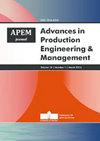高动态范围图像对摄影测量三维数字化精度的影响:一个案例研究
IF 2.8
3区 工程技术
Q2 ENGINEERING, MANUFACTURING
引用次数: 3
摘要
需要产品质量控制的小型初创公司通常只能负担得起低成本的系统。本研究的主要目的是评估高动态范围图像作为运动3D数字化低成本摄影测量结构输入的影响。各种由金属或聚合物制成的工业产品的视觉质感都很差。为了克服视觉纹理的缺乏,保证适当的三维重建,在产品表面以光模式的形式投射随机图像。在随机模式投影过程中,捕获并处理一组低动态范围和一组高动态范围的图像。在本研究中,使用了支持五种不同色调映射操作符的数字单镜头反光相机来创建高动态范围图像。此外,在坐标测量机上进行高精度测量,以验证实际产品的几何形状。得到的结果表明,与低动态范围图像生成的多边形三维模型相比,本案例中由高动态范围图像生成的多边形三维模型对精度的影响并不明显。为了估计三维模型的尺寸精度,使用计算机辅助检测分析对它们进行了比较。与标称CAD模型相比,基于高动态范围图像生成的3D模型的最佳标准偏差距离为+0.025 mm。本文章由计算机程序翻译,如有差异,请以英文原文为准。
Influence of high dynamic range images on the accuracy of the photogrammetric 3D digitization: A case study
Small and start-up companies that need product quality control can usually only afford low-cost systems. The main goal of this investigation was to estimate the influence of high dynamic range images as input for the low-cost photogrammetric structure from motion 3D digitization. Various industrial products made of metal or polymer suffer from poor visual texture. To overcome the lack of visual texture and ensure appropriate 3D reconstruction, stochastic image in the form of the light pattern was projected on the product surface. During stochastic pattern projection, a set of low dynamic range and sets of high dynamic range images were captured and processed. In this investigation digital single lens reflex camera that supports five different tone-mapping operators to create high dynamic range images were used. Also, high precision measurements on a coordinate measuring machine are performed in order to verify real product geometry. The obtained results showed that reconstructed polygonal 3D models generated from high dynamic range images in this case study don’t have a dominant influence on the accuracy when compared to the polygonal 3D model generated from low dynamic range images. In order to estimate 3D models dimensional accuracy, they were compared using computer-aided inspection analysis. The best achieved standard deviation distance was +0.025 mm for 3D model generated based on high dynamic range images compared to the nominal CAD model.
求助全文
通过发布文献求助,成功后即可免费获取论文全文。
去求助
来源期刊

Advances in Production Engineering & Management
ENGINEERING, MANUFACTURINGMATERIALS SCIENC-MATERIALS SCIENCE, MULTIDISCIPLINARY
CiteScore
5.90
自引率
22.20%
发文量
19
期刊介绍:
Advances in Production Engineering & Management (APEM journal) is an interdisciplinary international academic journal published quarterly. The main goal of the APEM journal is to present original, high quality, theoretical and application-oriented research developments in all areas of production engineering and production management to a broad audience of academics and practitioners. In order to bridge the gap between theory and practice, applications based on advanced theory and case studies are particularly welcome. For theoretical papers, their originality and research contributions are the main factors in the evaluation process. General approaches, formalisms, algorithms or techniques should be illustrated with significant applications that demonstrate their applicability to real-world problems. Please note the APEM journal is not intended especially for studying problems in the finance, economics, business, and bank sectors even though the methodology in the paper is quality/project management oriented. Therefore, the papers should include a substantial level of engineering issues in the field of manufacturing engineering.
 求助内容:
求助内容: 应助结果提醒方式:
应助结果提醒方式:


